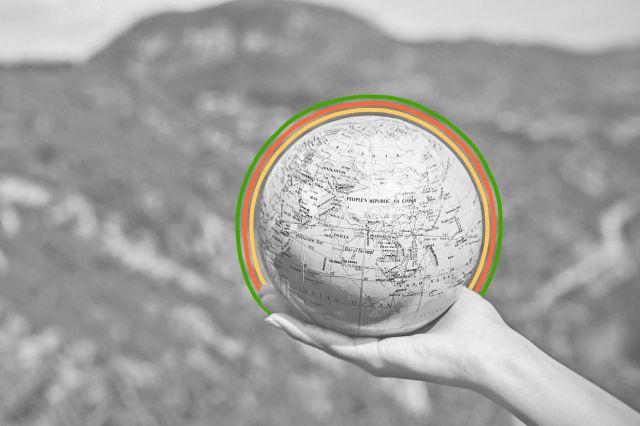
Cambria (Wales)
For most people, the small nation set on the southwestern coast of Great Britain is known as Wales, but others call it Cambria. While many historians agree that Cambria is the Latinized spelling of the Welsh name Cymru, some also point to the legend of the Trojan hero Brutus. In his 12th-century chronicle The History of the Kings of Britain, the cleric Geoffrey of Monmouth references Brutus landing in Britain and becoming its first king. Brutus changed the island’s name from Albion to Britannia and split it into three kingdoms, one for each of his sons. Locrinus received Logres (England), Albanactus was given Albany (Scotland), and Camber got Cambria (Wales).
The moniker Cambria survives in the names of Welsh landmarks and tourist attractions. Among them are the Cambrian Mountains and the Cambrian Line scenic railway, which crosses them. Hikers can trek nearly 300 miles from Cardiff to Conwy via the Cambrian Way trail. Cambria is also referenced in “Men of Harlech,” a military song that retells the events of a siege of Harlech Castle in the 1460s.

Suomi (Finland)
Tune into the Olympics or watch an international ice hockey match and you might see uniforms with the word “Suomi.” This is the Finnish name for Finland, the Northern European country known for thousands of lakes, the northern lights, and the wilderness of Lapland. The word’s origins are unclear, but there are a number of hypotheses. One suggests that it comes from suomma, which translates to “swampland,” and could relate to an ancient belief that the nation’s lakes were once swamps. An alternate theory considers the word suomo (“fish scale”) and implies that the Finnish people made clothes from fish skin. Some linguists speculate that the words Suomi and Sami — which refer to the native peoples of Finland, Norway, and Sweden — are derivations of zeme, a Proto-Baltic word for land or territory.
Travel to Finland and you’ll hear most Finns proudly refer to their nation and language as Suomi. In fact, Finland wasn’t a name invented by the Finnish; instead, it likely comes from the Old English word finna, once used to describe Scandinavian people. Interestingly, the letter “f” didn’t even exist in the Finnish alphabet, and was introduced through words borrowed from other languages .

Land of Noah (Armenia)
Armenia, the landlocked nation in the Caucasus region between Europe and Asia, is also known as the Land of Noah. The nickname stems from an extract in the Book of Genesis that states, “On the seventeenth day of the seventh month the ark came to rest on the mountains of Ararat.” It refers to Noah’s Ark and Mount Ararat, the first mountain that rose above the waters after the Great Flood. Although not located in Armenian territory today (it’s now in Turkey), Mount Ararat is a national symbol and revered by Armenians. It’s featured on the nation’s banknotes and coat of arms, which portrays Noah’s Ark on the mountaintop.
The Land of Noah’s biblical connections run deeper than the rumored resting place of the ark, however. Hayk, who claimed to be the great-great-grandson of Noah, is the forefather and founder of the first Armenian kingdom. In 301 CE, it became the world’s first country to adopt Christianity as the official state religion.
More Interesting Reads

Sakartvelo (Georgia)
If you ever visit Sakartvelo, you’d find yourself in a nation that stretches from the eastern shoreline of the Black Sea across the Caucasus Mountains. To much of the world this country is known by its western name of Georgia, but to Georgians themselves, it is Sakartvelo. This native name translates to “Land of Kartvelians,” and refers to the people who inhabited the country’s central region of Kartli. One of the first documented uses of Sakartvelo is found in the ancient Georgian Chronicles, and by the 1200s it referred to the entire unified medieval Kingdom of Georgia.
So why is the country widely known as Georgia? Some argue that it derives from gurgan, the Persian term for Georgians, while others say that it represents the native’s enthusiasm for St. George, or that it comes from a Greek word that means “tiller of the land.” Throughout much of the former Russian Empire, the country goes by the name Gruziya.

Wadadli (Antigua)
Antigua and Barbuda is an independent Commonwealth country located in the Caribbean, known for its pristine beaches and verdant rainforests. The country is made up of two islands, the lively and populated Antigua and the quieter Barbuda. Upon seeing Antigua for the first time in 1493, Christopher Columbus named the island Santa Maria de la Antigua after the miraculous virgin of a namesake chapel in Seville, Spain. Antiguans, however, call their island by its native Carib name of Wadadli. The name is associated with wadli, the Indigenous word for “oil,” and appeared in the 17th-century dictionary of the missionary Father Breton. The story goes that Dominican Caribs traveled to Antigua and collected oil to be utilized in medicines and as lighter fluid.
Visit one of Antigua’s dozens of beachfront bars and restaurants and there’s a good chance that you’ll find Wadadli lager beer and Wadadli Premium Gold on the menu. The soundtrack to a blissed-out Caribbean vacation is often the reggae beats of the Wadadli Experience Band — Antigua and Barbuda’s first Rastafarian band.











